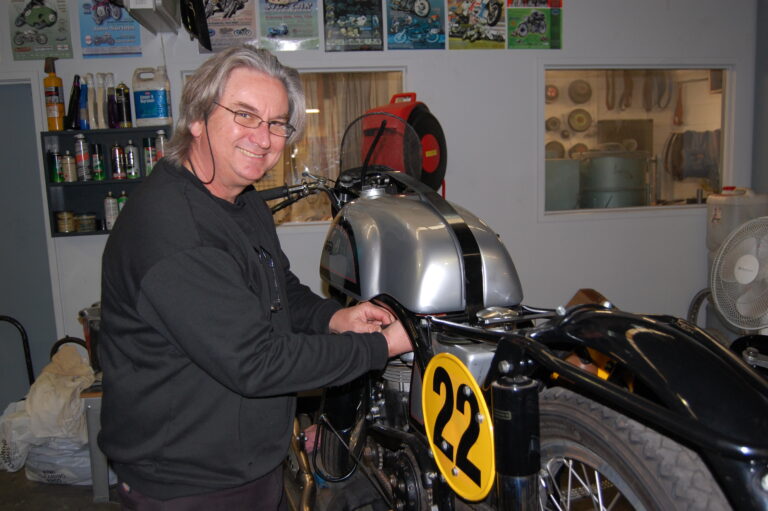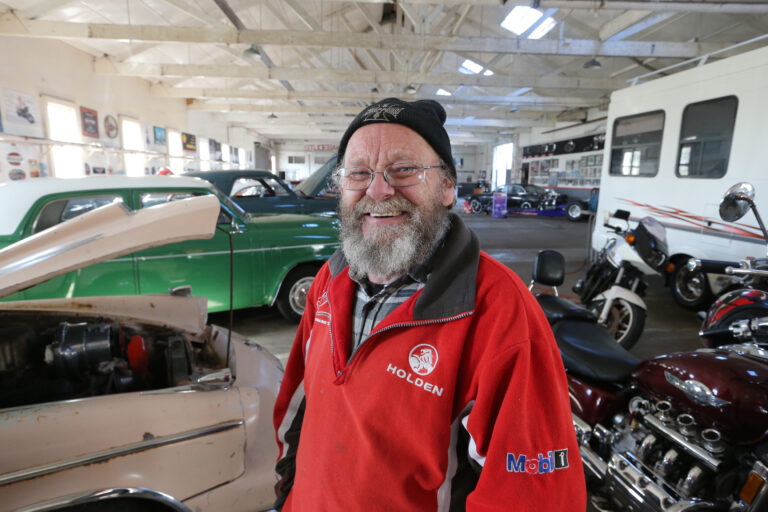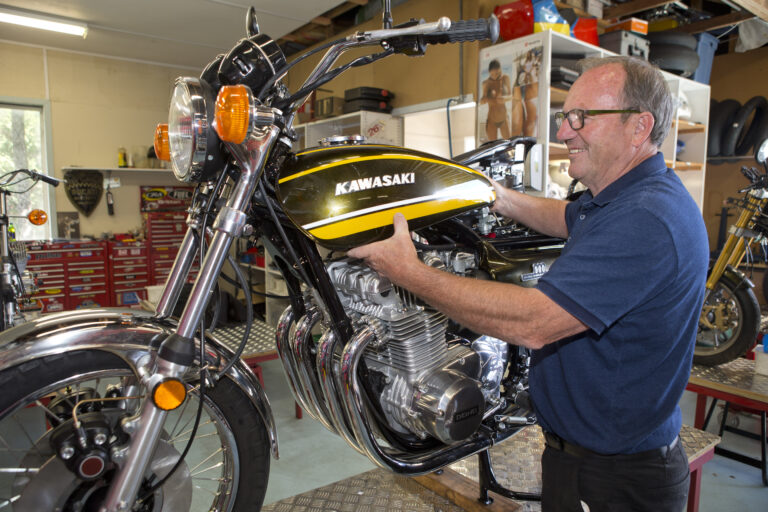The art of motorcycles and engineering
By Roger Lacey
Harley-Davidson museum poster
Most people have separate places for work, play, accommodation and their hobbies but Malcolm Anderson has successfully managed to combine them all into one.
His factory unit, nestled in a quiet street in East Auckland, has comfortable living accommodation, a comprehensive engineering, and fabrication workshop, and a display space showcasing his collection of motorbikes and associated memorabilia. Malcolm has engineers’ blue running through his veins. His grandfather started Anderson’s Garage in 1933 in what is now the heart of Remuera in upmarket Auckland. Malcolm’s father Bruce took over the family business and, after hours, hosted meetings for the motorcycle division of the Vintage Car Club of New Zealand.
While cars paid the bills, Malcolm’s father’s passion was collecting and restoring motorbikes to the highest standard. One of his projects, a 1929 Harley-Davidson OHV Two-port Special that he restored from a pile of parts, now resides in the Harley-Davidson Museum in Milwaukee in America. Bruce also supported Malcolm and his brother in motocross racing during their teenage years.
Room with “Italian” and “English” sides with memorabilia table…
..featuring fractured history…
…recalled in father-and-son memories by Malcolm (left) and Bruce.
In the late ’70s Malcolm started an engineering apprenticeship at Eric Paton Ltd in Penrose in Auckland. Bruce’s attention to detail must have rubbed off on him as he won the award for top 2nd-year apprentice and received the Sir Bernard Fergusson Cup for engineering excellence.
Through Bruce’s involvement in the Vintage Car Club, Malcolm met motorcycling legend, Ken McIntosh. Ken at the time was looking for help with rebuilding the Vincent engine he had purchased. They became friends, with Malcolm helping Ken after work and pit-crewing for Rodger Freeth (see end of this article) who rode an 1100cc McIntosh Suzuki and celebrated Arai 500 victories at Bathurst in 1982 and 1985.
In 1984 Malcolm was awarded the New Zealand Craftsman Training Award scholarship to further his training in Melbourne.
Although it was originally just a two-year scholarship, Malcolm stayed in Australia for five years, returning to New Zealand to work at Fisher & Paykel as a production engineer where he stayed for 20 years. While working at Fisher & Paykel, he started a sideline business making high-quality home accessories such as fire screens, magazine racks, and tables. When he chose redundancy from Fisher & Paykel, he worked fulltime on his home-ware business but has gradually changed focus towards high-precision engineering. Rather than trying to make a living restoring motorbikes, he does R&D work and produces jigs, fixtures, and one-off components. “The cost for me to restore a bike for someone would probably be far more than it’s worth” he says, adding, “besides, I prefer motorbikes to be my hobby, not my job.”
Father and son as racers, Bruce (foreground) on the 1948 Mk 8 KTT, Malcolm on the 1930 Mk 1 KTT he still races.
THE MOTORBIKES
2002 Ducati 748R
The last of the series developed as a road-going factory homologation special for the 750 Supersport World Championship racing series. The desmodromic [valves opened and closed by cams] V-twin has titanium valves and con rods.
1989 Honda VFR 400
A 400 cc version of the VFR 750R RC30 made for the Japanese market that favoured the smaller engine size. Its popularity saw the development of a race series based around them. The liquid-cooled, 16-valve V-four has gear-driven cams and a rev. red line of 14,500 rpm.
1976 Moto Morini 3½
Alfonso Morini started building racing motorbikes in 1925 before switching to manufacturing small-capacity, three-wheeled vehicles. After World War II, Morini switched back to making racing motorbikes. Giacomo Agostini started his racing career on a Moto Morini. The 3½ was a high-specification road bike launched in the early 1970s featuring Heron heads (flat cylinder heads with the combustion chamber in the piston). A 500cc version was also made.
1976 Moto Morini 3 ½.
1976 Yamaha YZ250
A popular 250 cc two-stroke motocross bike in the 1970s. The first production motocross bike to feature a mono-shock swingarm.
1948 Velocette KTT Mk 8
The last of the Velocette KTT series. One of two factory works bikes from that year, it was raced to 2nd place at the Isle of Man TT and 1st place in the Belgian Grand Prix by Bob Foster. Restored by Bruce and Malcolm Anderson, it was regularly raced by Bruce until his retirement in 2012.
1930 Velocette KTT Mk 1
The first of the successful KTT series. A 350 cc overhead-cam engine with a four-speed, close-ratio gearbox. Restored from a box of bits purchased in 1978. Malcolm made the cams and crankshaft for it and still races it.
1930 KTT Velocette Mark 1.
1928 Harley-Davidson 350cc side-valve
This “Pup” with optional Corbin speedometer. Rebuilt from the pieces of five motorbikes plus many parts hand-made by Malcolm.
1929 Harley-Davidson 350 OHV twin-port head “Peashooter.”
Owned and restored by Bruce Anderson and believed to be the only one in the world still racing.
1929 Velocette KNSS 350cc Freddie Hicks Replica
Ridden by Bruce, it has been clocked at 102 mph (163 km/h) at Pukekohe. Still, the fastest speed recorded [2014] for any classic 350 cc motorbike on that circuit.
My shed
Malcolm’s place is set in a block of non-descript factory/accommodation units, with no hint as to what lies behind the big roller doors.
The glass front door is hidden by a neat box hedge and trellis, adding a bit of texture and greenery to what would otherwise be a stark asphalt carpark. In the foyer, his “every day” road bikes, a Ducati 748R, and a Honda VFR 400 sit on floor stands made by Malcolm.
Behind them, a 1928 Harley-Davidson 350cc side-valve “Pup” is mounted on a custom-made display.
Malcolm’s father Bruce gave him the Harley as a box of bits when he was 14 and still at school. Comprising parts from five bikes, the collection took him 25 years to complete as a motorbike.
“Time overseas, marriage, kids and mortgage got in the way,” quips Malcolm, “but I always knew I was going to finish it.” He has re-made many parts for it, including the roller cam followers and the cylinder machined from a block of 4140 steel.
The thin cooling fins on the cylinder were turned, then the push-rod cut-outs were fly-cut into them. Malcolm also attended night school at Manukau Tech to gain the sheet-metal skills he needed to fabricate the toolbox. It’s not just a display model; he has ridden the bike up Rod Millen’s hill climb course at the Leadfoot Festival in Hahei.
Ducati moped
Parts for the 1929 Harley-Davidson “peashooter”
“Peashooter” Schebler carburettor.
Living
Upstairs is Malcolm’s living quarters, a two-bedroom unit with a kitchen/lounge leading to a small balcony. An Italian Bugatti espresso machine sits on the kitchen countertop.
The bright red machine is an example of Malcolm’s taste in design and love of fine engineering, which is evident throughout the building. The second bedroom lets either of Malcolm’s two grown-up children stay when they visit from Australia. The main workshop is downstairs and past the bikes in the foyer.
A lot of machinery is squeezed into a small space but everything is clean, tidy, and in its place. Down at one end are a surface grinder and a Myford cylindrical grinder. Next to a cabinet containing tools and accessories are his two lathes and beside them his two milling machines.
Stylish Bugatti coffee machine.
Lathe
The English Kerry lathe was Eric Paton’s own toolroom-quality, home workshop lathe.
Despite being more than 25 years old when sold to Malcolm, the lathe had only ever been used by Paton and was kept in immaculate condition. Paton always wanted to be a doctor but was told by his father he had to follow the family business. However, he became good friends with the surgeons at Auckland Hospital and over the years developed many innovative surgical tools and clamps in his spare time.
When Malcolm took delivery of the lathe it came with a cabinet chock-full of accessories, including nine chucks. Next to the work-bench in the centre of the room is Malcolm’s anvil, a family heirloom. It is made from a crosshead from a steam locomotive and Malcolm’s father Bruce, who was three at the time, remembers his father buying it in 1930 from a wrecking yard at the bottom of Khyber Pass Road in central Auckland.
To fit his business and his hobbies in one place, Malcolm ended up buying the unit next door. It is a mirror image of his original unit.
A motorcyclist’s machine shop
Leather with Velocette insignia contains 180,000 stitches
Piston in the Velocette display case of original Mk 8 parts beyond restoration
The second unit
The downstairs part of his second unit is the fabrication area with welders, sheet-metal equipment, and materials. (He has sealed the stairs from the workshop and is renting out the upstairs accommodation area. To keep his tenant happy while he works, he has lined the walls with a thick layer of soundproof foam insulation.)
Refrigerator crisper drawers (“seconds” from Malcolm’s time at Fisher & Paykel) are used for storage. They are even hung from the ceiling. The fabrication area is also being used as temporary storage for Malcolm’s next project, a Yamaha YZ250 motocross bike that he bought in memory of his favourite YZ he raced as a kid.
Piston in the Velocette display case of original Mk 8 parts beyond restoration
Velocette
Leading from the fabrication workshop is the entrance to Malcolm’s real Aladdin’s cave.
A treasure trove of Italian and British motorcycles and memorabilia has been artfully arranged to showcase Malcolm’s many passions. The room is approximately divided into an Italian side and a British Velocette side, interspersed with a smattering of Harley-Davidson posters and curios.
The Velocette side of the room has the 1930 KTT Mk1 that Malcolm races and the historic 1948 KTT Mk 8 raced by his father. The K series Velocette was developed as a production racer specifically for the Isle of Man TT race. Hence, the Velocette KTT which was produced form 1929 to 1949.
A showcase displays what Malcolm refers to as the DNA of the Mk 8 which came 2nd in its class at the 1948 Isle of Man TT and won the Belgian Grand Prix the same year. It was bought as a wreck by his father Bruce and all the original parts unable to be re-used on the restoration, are on show.
The crankshaft, conrod, cams, and pistons are all on display along with the original magnesium wheel hubs. Hung on the wall is a set of leathers embroidered with the Velocette insignia containing 180,000 stitches. “It was the largest project the embroidery shop had ever done,” comments Malcolm.
Family heirloom anvil from a steam locomotive
Italian
Along the opposite wall from the Mk 1 Velocette, an immaculate Moto Morini 3½ represents the Italian side of the room. Malcolm bought the bike during his time in Australia and has now owned it for 30 years, restoring it about five years ago.
During the work, he commissioned local company Spincast Manufacturing to make a run of replica badges, which he now sells around the world. Mounted on the wall above the Morini is a 1955 Ducati Cucciolo—a 48 cc pull-rod four-stroke moped—the first Ducati motorbike that serves to highlight the advances made over almost 50 years which culminated in the homologation special Ducati 748R in the foyer.
Separating the two sides of the room, an entire wall is taken up with illuminated glass shelving made by Malcolm containing reference books, helmets, models, and a Ducati desmodromic cylinder head. In front of the shelves, a glass-topped coffee table made from a Ducati wheel sits between two comfy red leather chairs.
On the “Italian side,” a Ducati desmodromic cylinder head
Memorabilia
The centrepiece of the room is a glass-topped, stainless steel table that Malcolm has made, displaying a fascinating array of memorabilia.
Smashed and burnt pistons, cams, valves, and a bent conrod are artfully arranged around documentation that tells part of the story behind them. When Malcolm or his father are prompted, they can each fill in the stories surrounding the parts.
A Harley-Davidson “Peashooter” carburettor in the centre of the display is one of four, cast, and machined from an original that was lent to Malcolm’s father by Thomson’s Motorcycle Museum in the Manawatu. A gear shift pedal for the Velocette was made by Malcolm from scratch.
Revolutionary in its day (previously, most motorbikes used hand-operated gears), the mechanism kept the pedal in the same position when indexing through the gears and was the forerunner of modern motorbike gearboxes. The entire room is comfortable, opulent and a great place to entertain like-minded friends, relive the past and to plan future projects.
Though only a few steps away from the workshop, it seems like another world. It is obvious that Malcolm makes sure there are boundaries between living, work, and leisure. There are no motorbike parts lying about his workshop nor do any engineering bits creep into his living space or downstairs lounge area. With care, thought and planning, Malcolm has achieved a rare, perfect balance between his work, life, and play and done it without compromise.
Malcolm as precision engineer
Rodger Freeth
Malcolm has fond memories of Rodger Freeth and working with him.
He relates, “One year at Bathurst, Ken (McIntosh) worked out that if the bike carried extra fuel, it would need one less pit stop than the more powerful Yamahas. He fabricated a huge fuel tank that Rodger had to stretch over and then wrestle the extra weight around the mountain until the fuel load lightened.”
Another story relates to Rodger’s academic brilliance, “Rodger had a PhD in astrophysics and in 1986 had the honour of being invited by NASA to crew aboard a specially constructed aircraft to fly at high altitude to observe and make measurements of Halley’s comet.
Rodger asked what date the flight was, then declined them saying, ‘No, I’m racing at Bathurst that weekend’.” Sadly, Rodger was killed in 1993 while navigating for Possum Bourne on the first day of Rally Australia.



